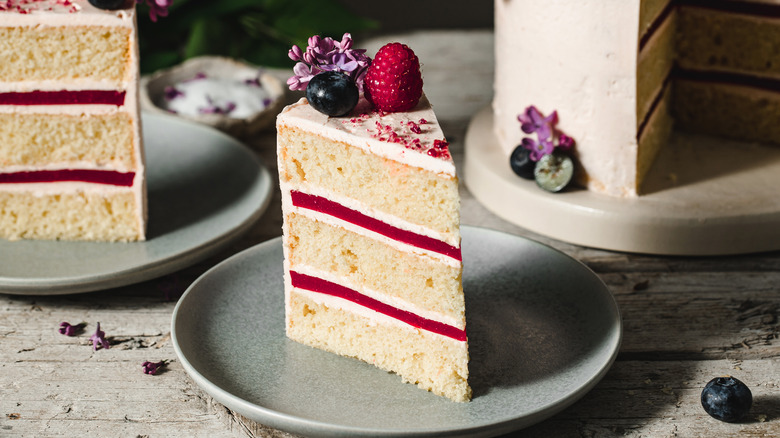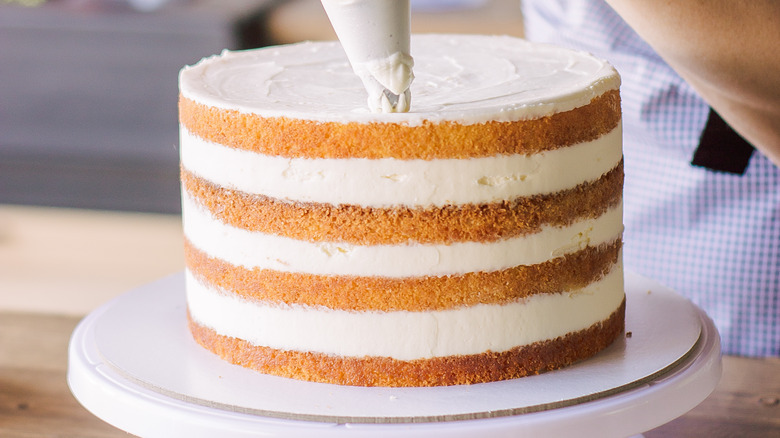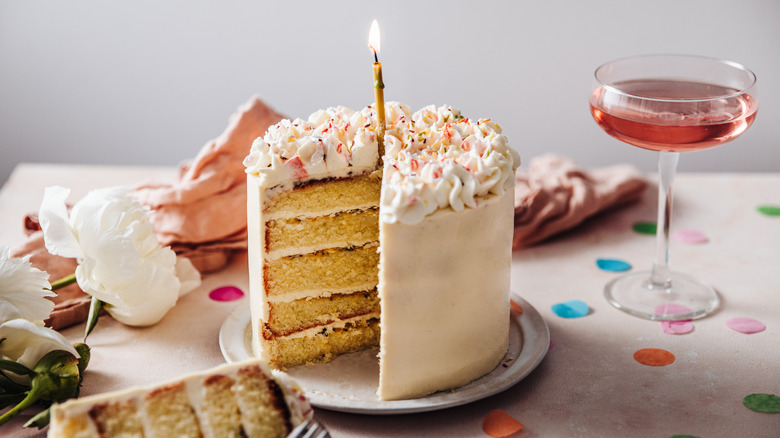The Frosting Tip That Will Prevent Your Layer Cake From Oozing
Baking a cake presents a few challenges, from ensuring the right ingredients are combined in proper proportions to baking it for the ideal duration to maintain its moistness and prevent dryness. Equally crucial is the assembly, filling, and decoration of the cake to prevent frosting and fillings from slipping and sliding. When dealing with looser fillings, referred to as "wet fillings" — such as puddings, compotes, or pastry creams — there is a near foolproof technique that most seasoned professionals employ. To prevent these more liquid fillings from spilling out, bakers often create a buttercream dam along the outer perimeter of each filled layer.
Although this method might appear straightforward, it necessitates precise execution. If done correctly, the dam will prevent the wet filling from spilling out the sides, keep the upper layer from shifting, and not ooze out the sides itself. Luckily, there are some expert-approved strategies for achieving flawless results every time.
The proper technique for crafting a frosting dam
While numerous professional and amateur cake artists have their own methods for creating an essential cake dam, the best approach is showcased in a YouTube video from baking brand Wilton. First, you'll want to apply a small amount of frosting to attach the base cake layer to a raised cake pad, securing it with a touch of icing between the cardboard and the bottom of your cake. Ideally, you should place this assembly on a turntable designed for frosting cakes. Holding a buttercream-filled piping bag, you can then exert pressure while simultaneously turning the turntable with your other hand. You want to start the piping about a ¼ inch from the cake's edge. "You want to avoid being too close," advises the chef. Maintain steady pressure and motion, allowing a consistent line of buttercream to spread evenly around the outer edge without interruption. This technique guarantees that your liquid filling remains contained.
When introducing your wet filling, the top tip from Wilton emphasizes ensuring that the filling is level with the height of the icing dam. This equal height ensures uniform layers and cohesion. To spread the filling, use an offset spatula and move side to side; avoid lifting rapidly, as this could cause the filling, frosting, or even cake crumbs to dislodge, compromising the evenness. Gently place the next cake layer on top and press down softly to unite the layers.
Additional pointers for achieving a flawless cake frosting
Although the frosting dam technique is important when incorporating wet fillings, Wilton offers additional advice for maintaining layer integrity. When assembling your cake, begin with the "baked" side facing upwards — this prevents fillings from shifting to the side. Flipping the cake exposes the leveled layer that was in contact with the flat pan surface. This approach not only thwarts any filling migration but also eliminates crumbs, as there's no need for manual layer trimming, a task that can prove challenging even for seasoned bakers.
Wilton also suggests using a cardboard cake circle beneath the base layer. This cardboard support adds a raised edge encircling the cake, offering a grip to facilitate transferring the cake from the frosting location to the final serving platter. If a cake circle isn't available, ensure you frost directly on your cake stand or plate. This prevents the need for moving the cake once it's fully frosted.


